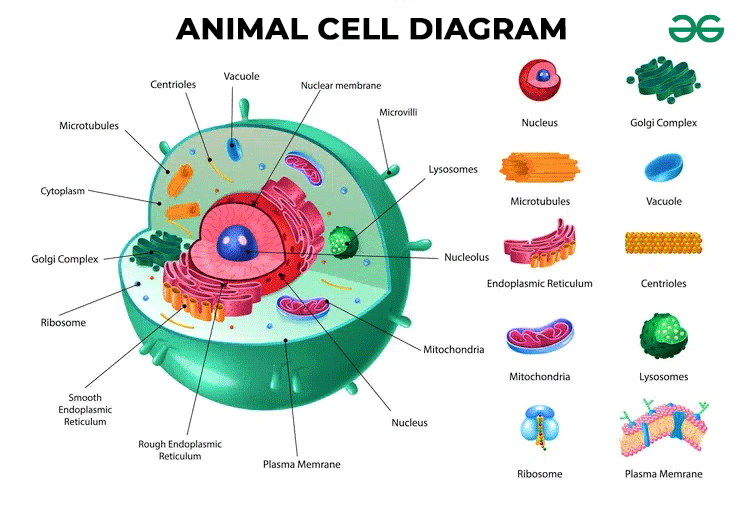Diagram of Animal Cell
Last Updated :
15 Mar, 2024
An animal cell diagram is useful for understanding the structure and functioning of an animal. The animal cell function includes energy production, transportation, protein synthesis, cellular communication, movement, and maintenance of structure. Various animal cell parts known as animal cell organelles have specialized roles.
Animal cells are eukaryotic cells with a membrane-bound nucleus. Since they do not have cell walls and chloroplasts, they are distinct from plant cells. In this article, we will learn a well-labeled animal cell diagram and a brief description of each component in the cell.
Definition of Animal Cell
The fundamental structural and functional building blocks of animal tissues and organs are known as animal cells.
What are the Animal Cells?
Animal cells are eukaryotic cells without a cell wall and have various cell organelles and a membrane-bound nucleus. The plasma membrane encloses an animal cell. Compared to plant cells, they are smaller. Due to the absence of a cell wall, they are typically uneven in shape and might be round, oval, rod-shaped, spherical, or rectangular. Animal cells can generate a wide variety of cell types, tissues, and organs since they lack a cell wall. When a cell wall is present or absent, animal cells can easily be recognized from plant cells. These cells have several membrane-bound organelles surrounding the nucleus.
Also Read: Facts about Animal Cell
Well-Labeled Animal Cell Diagram
The diagram of the structural organization of an animal cell is presented below, with the organelles identified and labeled:

Structure of Animal Cell
The different animal cell organelles are listed below.:
- Cell Membrane: The double-layered membrane that covers the entire cell and is formed of phospholipids is known as the cell membrane. Only specific molecules can flow through the membrane since it only permits selective permeation.
- Cytoskeleton: The tubule and filament network known as the cytoskeleton is present throughout the cytoplasm. It gives the cell the right shape and participates in cell signaling.
- Nucleus: DNA is found in the nucleolus portion of the nucleus, which is where the genetic material is stored. A nuclear membrane separates the nucleus from the remainder of the cell. It controls how cells divide and grow as well.
- Cytosol: The liquid found inside cells, known as cytosol, contains water, ions like potassium, proteins, and tiny molecules.
- Ribosomes: Ribosomes can be seen floating around in a cell’s cytoplasm or bound to endoplasmic reticulum membranes. They support the production of proteins.
- Endoplasmic Reticulum: The nuclear membrane splits off into a network of membranous sacs called cisternae that make up the endoplasmic membrane. The two different types are smooth endoplasmic reticulum and rough endoplasmic reticulum. It facilitates the transportation of proteins made by ribosomes.
- Vesicles: A vesicle is a structure inside or outside of a cell that is made up of cytoplasm or liquid and is surrounded by a lipid bilayer. The vesicles aid in the movement of chemicals between organelles.
- Golgi Apparatus: The endoplasmic reticulum delivers proteins to the Golgi apparatus, which then packages them into vesicles.
- Mitochondria: The “powerhouse of the cell” is yet another name for the mitochondria. During this process of cellular respiration, energy is liberated as ATP.
Types of animal cells
There are various types of animal cell which perform specific functions and are listed below
- Muscle cells: – Myocytes, cardic muscles, myostallites cells and tendon cells
- Skin cells: – Melanocytes and keratinocytes
- Nerve cells: – Glial cells and Schwann cells
- Blood cells: – WBCs, RBC and platelets
- Fat cells: – Adipocytes
Conclusion – Animal Cell
Animal cells come in various shapes and sizes, each with its own specific function. Some animal and plant cells can play same function as both are eukaryotic in nature. However, animal cells require an external food source because they lack specialized organelles like chloroplasts. In conclusion, while the animal cells may vary in form and function, they all work together to maintain life processes in organisms.
Also Read:
FAQs on diagram of animal cells
What is Animal Cell Diagram?
The animal cell diagram is frequently featured in Class 10 and 12 examinations, offering a valuable tool to comprehend the structure and functions of an animal cell.
What is Nucleus?
In genomics, the nucleus is the membrane-enclosed organelle housing chromosomes within a cell. Pores in the nuclear membrane facilitate the selective passage of molecules, including proteins and nucleic acids, to enter and exit the nucleus.
What is a Lysosome?
A lysosome is a membrane-bound cell organelle containing digestive enzymes and participating in various cellular processes. Its primary function is to break down excess or worn-out cell parts.
What is the Unique Structure of the Animal Cell?
Animal cells feature centrosomes and lysosomes, distinguishing them from plant cells, which lack these structures. Conversely, plant cells possess a cell wall, chloroplasts, specialized plastids, and a prominent central vacuole, all absent in animal cells.
What are 3 Special Animal Cells?
Specialized animal cells encompass red blood cells, sperm, eggs, nerve cells, muscle cells, ciliated cells, and villi.
What are the Function of Animal Cell Parts?
Animal cell parts perform functions such as energy production, protein synthesis, cellular communication, and maintenance of structure, ensuring the cell’s survival and proper functioning within the organism.
Where to Find Animal Cell Diagram Class 8?
A well labelled animal cell diagram is given here.
What is the Difference Between Animal and Plant Cell?
Animal cells lack cell walls and chloroplasts found in plant cells, while possessing lysosomes and centrioles, which are generally absent in plant cells.
Share your thoughts in the comments
Please Login to comment...